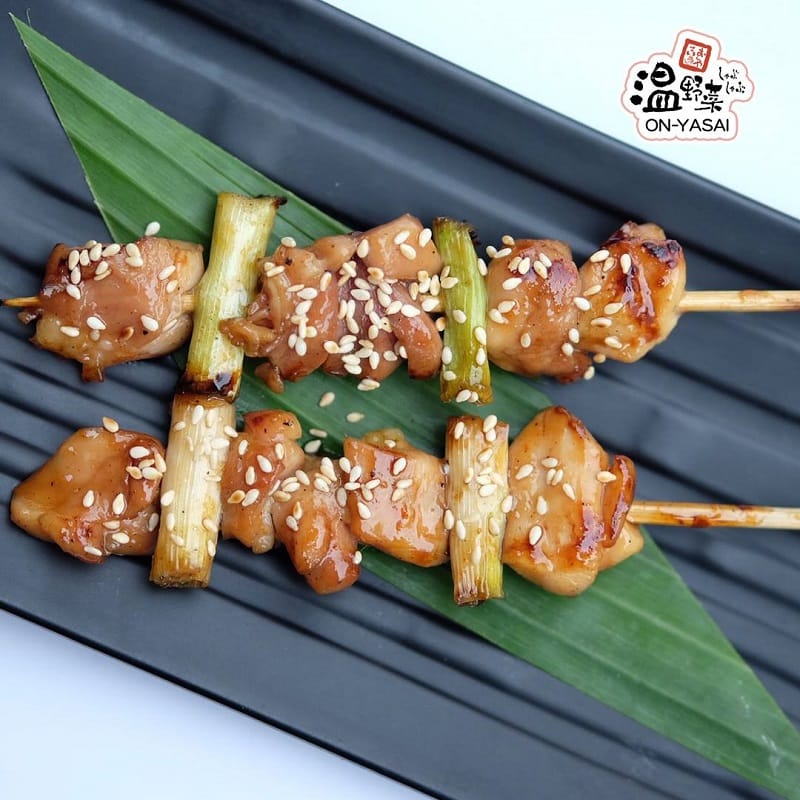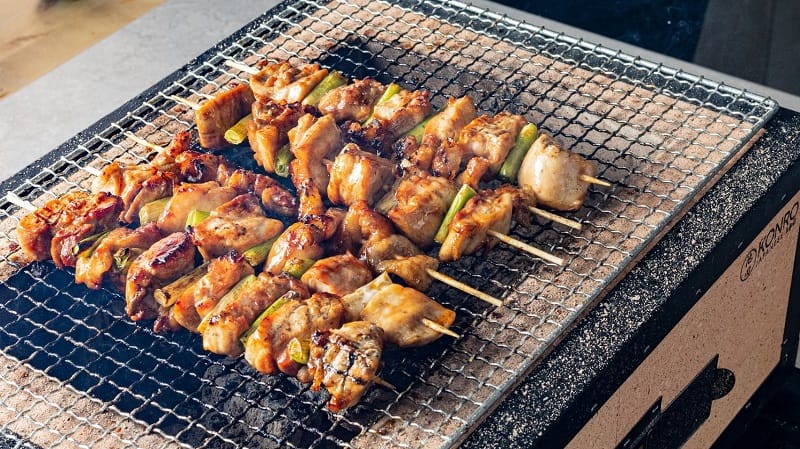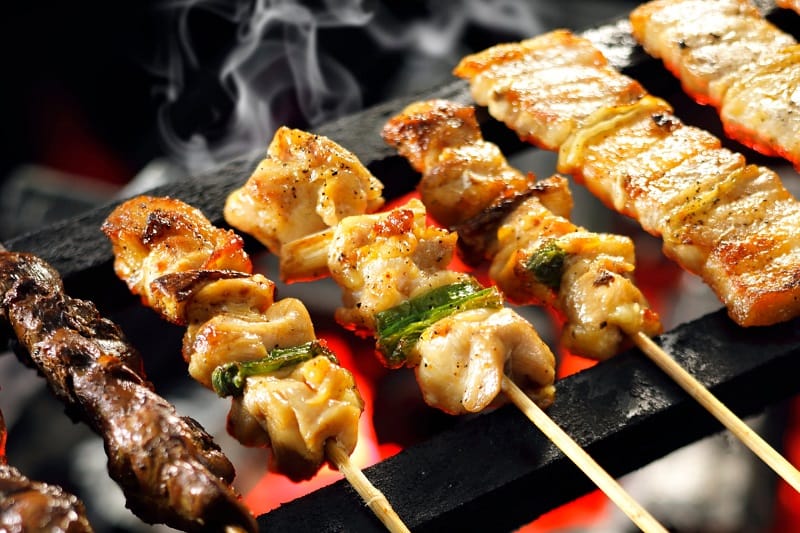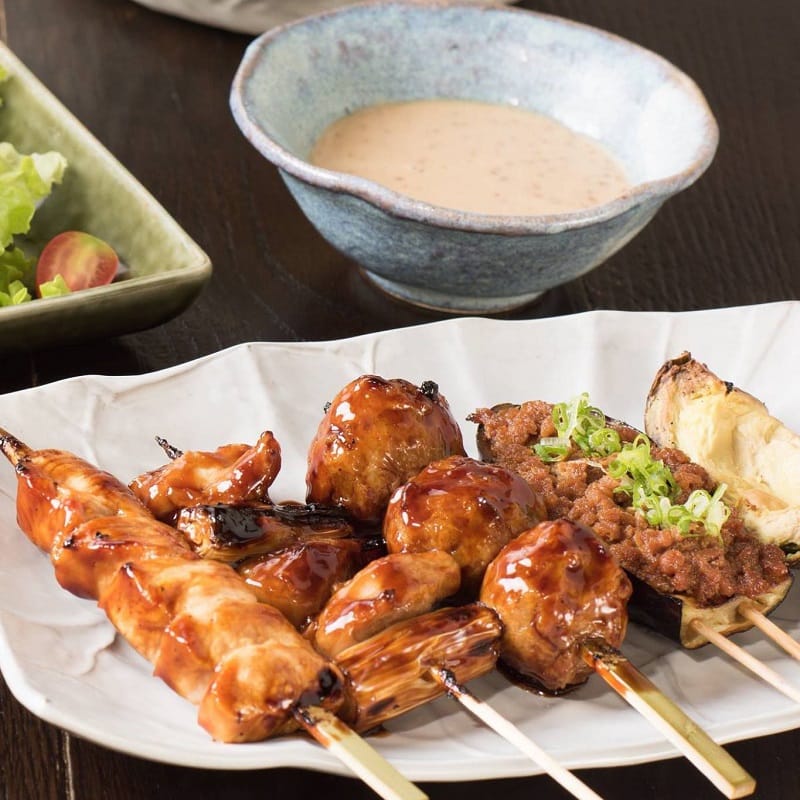In this article, we will delve into the world of Yakitori – a popular Japanese dish enjoyed since ancient times. So, What is Yakitori? It is a skewered chicken dish grilled over charcoal, giving it a unique, smoky, unmatched flavor. We will walk you through Yakitori’s history, preparation, and variations so that by the end of this article, you will have a greater appreciation and understanding of this delicious dish. So, please sit back, relax, and let us take you on a journey through the world of Yakitori.
What Is Yakitori? How Is It Different From Other Grilled Food Items?
Yakitori is a traditional casual Japanese meal consisting of bite-sized pieces of meat, usually chicken, served on a bamboo skewer. The term yakitori can be translated from the Japanese words yaki (grill) and tori (chicken). In Japan, yakitori is widely available as street food or a casual meal served in a parlor, frequently paired with Japanese beer or sake.
In the United States, it is becoming increasingly trendy in restaurants, with chefs using all parts of the chicken for their skewers and getting creative with other proteins and foods.
Yakitori is typically prepared over binchotan, Japanese white charcoal, or substitute charcoal such as lump or briquette, kept burning low at around 200 degrees Fahrenheit so the meat cooks slowly. A chef constantly rotates the meat, basting it with a soy-based sauce called tare, which consists of Japanese rice wine, scallions, ginger, sugar, soy sauce, sake, and spices.
Yakitori can also be prepared at home using small electrical appliances known as yakitori-ki. The seasoning of yakitori is primarily divided into two types: salty or salty-sweet. Its portability makes it a popular street food often sold from small carts and stalls called yatai. Yakitori takes on many forms due to a wide diversity in cuts and preparation methods.
A few things make Yakitori different from other grilled food items.
- Firstly, the way the chicken is prepared is unique. The chicken pieces are cut into small, bite-sized portions and then skewered onto bamboo sticks. These skewers are then grilled over a charcoal fire, giving them a smoky flavor that’s hard to replicate with other grilling methods.
- What’s interesting about Yakitori is that it’s not just limited to chicken. While chicken is the most common meat, you can also find Yakitori made with beef, pork, seafood, and vegetables like mushrooms and asparagus.
- Another thing that sets Yakitori apart from other grilled food items is the seasoning. The chicken is typically marinated in a sauce made from soy sauce, sake, mirin, and sugar before being grilled. This marinade not only adds flavor to the chicken but also helps to tenderize it.
What Are The Origins Of Yakitori?
To start with, it’s important to understand that yakitori has been a part of Japanese cuisine for centuries, dating back to at least the Edo period (1603-1868). However, the dish as we know it today has evolved.
One theory about the origins of yakitori is that samurai warriors first ate it during the Edo period. The story goes that the samurai would skewer small pieces of chicken and cook them over an open flame to prepare a protein-rich meal quickly while on the go. This theory is supported by yakitori being considered initially street food.
Another theory is that yakitori was influenced by Chinese cuisine. In particular, the method of skewering and grilling meat is similar to a Chinese dish called chuanr. It’s possible that yakitori was a Japanese adaptation of this dish.
Regardless of its exact origins, it’s clear that yakitori has become a beloved and iconic dish in Japan. It’s so popular that entire restaurants are dedicated solely to serving yakitori.
Read more:
What Are Some Popular Variations Of Yakitori Found In Different Regions Of Japan?

Here are some of the most popular variations of yakitori that you can find in different regions of Japan:
- Negima in Kanto: Negima is a popular yakitori form featuring juicy chicken thigh pieces and grilled Japanese leeks in this region. It is typically seasoned with tare for a sweet and savory flavor.
- Tebasaki in Nagoya: Nagoya is famous for its crispy and flavorful tebasaki yakitori, made from chicken wing tips grilled and seasoned with soy sauce, garlic, and ginger.
- Torikawa in Tokushima: Torikawa is a unique form of yakitori found in Tokushima that features crispy chicken skin that has been grilled to perfection. It is often seasoned with salt and served with a squeeze of citrus for added flavor.
- Tsukune in Osaka: Osaka is known for its delicious tsukune yakitori, which features hand-formed chicken meatballs seasoned with tare sauce, and often topped with a raw egg yolk for extra creaminess.
- Bonjiri in Hiroshima: In Hiroshima, a bonjiri yakitori is a popular option featuring meat from a chicken tail. It is typically skewered and grilled to perfection, then seasoned with salt and lemon for a tangy and savory flavor.
- Sunagimo in Kyushu: Sunagimo, or chicken gizzards, are a popular form of yakitori in Kyushu. They are often marinated in soy sauce-based seasoning, then skewered and grilled until crispy and flavorful.
- Negima-maki in Ibaraki: In Ibaraki, Negima-maki yakitori is a favorite dish that features chicken thigh wrapped around pieces of Japanese leek, then grilled to perfection and seasoned with tare sauce for added flavor.
- Hatsu in Kyoto: Hatsu is a popular form of yakitori in Kyoto that features chicken hearts skewered and grilled until tender and juicy. It is often seasoned with salt and served with shichimi togarashi pepper for extra flavor.
- Sasami in Tohoku: In Tohoku, sasami yakitori made from chicken tenderloin is a popular option. It is often seasoned with shio for a simple and savory flavor and can be enjoyed on its own or paired with other yakitori varieties.
- Kashiwa in Hokkaido: Hokkaido is known for its Kashiwa yakitori, which features chicken thigh meat marinated in a spicy miso-based sauce, then grilled to perfection for a rich and flavorful dish.
Each variation has a unique flavor and texture, making yakitori a versatile and delicious street food many love. Whether you’re in Tokyo, Osaka, Nagoya, Kyoto, or Fukuoka, be sure to try out the local variations of yakitori and experience Japan’s amazing flavors.
What Types Of Meat Or Vegetables Are Typically Used In Yakitori?
As someone who has tried various types of yakitori over the years, I can confidently say that the choices available can initially be overwhelming. However, with a bit of knowledge and experimentation, you’ll soon find your go-to favorites.
Let’s start with the meat options. Chicken is the most commonly used type of meat for yakitori and is often referred to as “tori” in Japanese. Chicken thighs, known as “momo,” are popular due to their tenderness and juiciness. Chicken breast, or “sasami,” is also commonly used and is a leaner option. Other types of poultry, such as quail, are sometimes used as well.
Beef, or “gyu,” is another meat option for yakitori. Though not as commonly used as chicken, beef skewers can be found in some restaurants and are usually made with cuts such as sirloin or tenderloin.
Pork, or “buta,” is also used in yakitori and is usually made with cuts such as belly or loin. The fat content of pork makes it a flavorful and juicy option for skewers.
Seafood can also be found in yakitori, with shrimp, scallops, and squid being some of the most popular choices. Vegetarian options are also available, with mushrooms, peppers, and eggplant skewered and grilled to perfection.
One thing to remember when ordering yakitori is that the different parts of a chicken or other animal may be used, including parts that may not be as familiar to Western palates. For example, “nankotsu” refers to chicken cartilage, often used in yakitori, and can be quite delicious when cooked properly.
What Makes Yakitori Popular Street Food In Japan?

I’ve noticed one type of street food that always seems to draw a crowd: Yakitori. But what about Yakitori makes it such a beloved street food in Japan?
First and foremost, yakitori’s simplicity makes it so appealing. The dish is made up of small bite-sized pieces of chicken that are skewered and grilled over charcoal. The seasoning is kept to a minimum, usually just salt or tare (a sweet and savory soy sauce-based glaze), which allows the chicken’s natural flavor to shine through. This simplicity also makes it easy to eat while walking around, which is why it’s popular street food.
Another reason why yakitori is so popular is its versatility. While chicken is the main ingredient, many different cuts and parts of the chicken can be used, each with its unique flavor and texture. Some popular cuts include thigh meat, breast meat, skin, liver, and even cartilage. It’s common to see vegetables like shishito peppers and mushrooms skewered alongside the chicken.
Yakitori is also a very social food. Many Yakitori restaurants and stands are small and cozy, with limited seating. This means that it’s common to share a table with strangers, which can lead to interesting conversations and a sense of community. The atmosphere is usually lively and casual, with sizzling chicken and lively chatter filling the air.
Finally, yakitori is simply delicious. The combination of juicy, tender chicken and smoky, charred flavor from the grill is winning. The simplicity of the seasoning allows the natural flavors of the chicken to shine through, while the occasional brush of tare adds an extra layer of sweetness and umami.
What Is The Marinade Used In Yakitori?
The marinade used in Yakitori typically consists of a savory-sweet sauce made from soy sauce or tamari, mirin, sake, dry sherry, garlic, ginger, and a touch of brown sugar.
Chicken thighs, gizzards, or livers are marinated in the sauce for at least one hour, up to four hours, to infuse the flavors into the meat. The marinated chicken pieces are then threaded onto bamboo skewers and grilled or broiled for a few minutes on each side until cooked through.
The resulting dish is a tender and flavorful chicken skewer that can be served alongside fresh greens and rice. Nutritional analysis per serving shows that this dish is relatively low in calories but high in protein, with moderate sodium due to the soy sauce.
How Is Yakitori Prepared?

To prepare yakitori, you need to start with the right type of chicken. The most commonly used chicken for yakitori is thigh meat. It has a good balance of fat and meat, making it perfect for grilling. The chicken is cut into bite-sized pieces and skewered onto bamboo sticks.
The next step is to season the chicken. Yakitori is traditionally seasoned with a simple mixture of soy sauce, mirin, and sugar. This mixture is known as tare and is brushed onto the chicken as it cooks. The tare gives the chicken a sweet and savory flavor and caramelizes on the surface of the meat.
Once the chicken is seasoned, it is time to grill it. The grilling process is done over hot coals and requires constant attention. The chicken is placed on the grill and turned frequently to ensure even cooking. The grilling process takes about 10 to 15 minutes and requires a lot of patience and skill.
As the chicken cooks, it is basted with the tare sauce to keep it moist and flavorful. The heat from the grill also helps render the chicken fat, making it juicy and tender.
Once the chicken is fully cooked, it is removed from the grill and served hot. Yakitori is often served with a side of rice and a cold beer. It is a delicious and satisfying dish that is perfect for any occasion.
How to Order at a Yakitori Restaurant?

Customers can easily indicate their desired skewers by pointing at the menu or using simple Japanese phrases to order at a Yakitori restaurant.
- They can start by saying, “Sumimasen!” (Excuse me!) and then proceed with “Kore o ippon onegai-shimasu” (Can I have one skewer of this one, please?) or “Nihon sanbon yonhon” (2 skewers, 3 skewers, 4 skewers…).
- Customers can also ask for recommendations by saying, “Osusume ha nan desu ka?” (What is your recommendation?).
- Regarding sauce preference, they can choose either tare (soy sauce-based) or just salt. To indicate their preference, customers can say “Tare/Shio de onegai-shimasu” (With tare/salt, please).
- Lastly, when it’s time to pay, they can say, “Okanjo onegai-shimasu” (The bill, please).
With this simple guide, customers can enjoy the many types of yakitori offered at the restaurant.
What Is The Best Way To Enjoy Yakitori, And What Are Some Tips For First-Time Tasters Of This Dish?
If you’re a first-time taster of Yakitori, here are some tips to help you enjoy this dish to the fullest.
- Please start with the basics: Regarding Yakitori, the most basic type is the salted version. This is a great place to start if you’re new to the dish. The salt enhances the flavor of the chicken without overpowering it, and it’s a great way to get a feel for the dish.
- Experiment with sauces: Once comfortable with the salted version, dip your Yakitori in different sauces. Different sauces are available, from the sweet and savory Teriyaki sauce to the spicy and tangy Wasabi sauce. Try a few different sauces and see which ones you like best.
- Try different cuts of chicken: Yakitori can be made with virtually any part of the chicken, from the breast to the liver. Each cut has a slightly different flavor and texture, so don’t be afraid to try different cuts. Some popular cuts include thigh meat, skin, and meatballs.
- Don’t overlook the vegetables: While Yakitori is traditionally made with chicken, many restaurants also offer vegetable skewers. These can be a great way to balance the meal and add variety to your plate. Some popular vegetables for Yakitori include shishito peppers, mushrooms, and onions.
- Drink sake: Sake is a traditional Japanese rice wine that pairs perfectly with Yakitori. It’s light and refreshing and perfectly complements the chicken’s flavors. If you dislike sake, pair your Yakitori with a light beer or a crisp white wine.
FAQs About What Is Yakitori
What Is The Meaning Of “Yaki” And “Tori” In Yakitori?
The word “yaki” in Japanese means grilled or toasted, while “tori” means bird. Therefore, the term “yakitori” refers to grilled chicken on skewers. This traditional Japanese dish consists of small pieces of skewered chicken meat grilled over an open fire.
Yakitori is a popular food in Japan and is commonly served as an appetizer or a snack. The dish can be flavored with a sweet and savory glaze sauce or seasoned with salt and white pepper. Yakitori is also made using other meats such as pork, beef, and vegetable skewers.
Can Yakitori Be Made With Other Meats Like Beef And Pork?

Yakitori is a traditional Japanese dish with marinated or seasoned chicken grilled on skewers. Although chicken is the most popular meat in yakitori, other meats, such as beef and pork, can also be used. The meat is cut into small pieces and skewered with vegetables such as onion or leek.
The meat is then grilled over an open flame and served with various sauces. The most common seasoning for yakitori is Tare, a soy sauce, sake, mirin, and sugar sauce. Shio, which is simply salt and pepper, can also be used.
Vegetarian and vegan options are also available. Yakitori is a versatile dish that can be made with different meats and vegetables to suit different tastes.
Why Is Yakitori Commonly Eaten With A Cold Beer?
Yakitori is commonly eaten with cold beer in Japan and other parts of the world. This is because the salty, savory, and slightly sweet flavors of the grilled chicken skewers pair perfectly with beer’s carbonated and refreshing taste. Additionally, the beer helps to cleanse the palate between bites, allowing the flavors of each skewer to shine through fully.
Enjoying yakitori and beer at a yakitori parlor is a popular after-work activity in Japan. It provides a relaxing and casual setting for socializing and unwinding with friends or colleagues.
What Is The Traditional Japanese Cuisine Associated With Yakitori?
Yakitori is a Japanese cuisine that is traditionally associated with grilled chicken. The preparation of Yakitori involves skewering pieces of chicken meat on a type of skewer made of steel, bamboo, or similar materials and grilling them over a charcoal fire. The meat is then seasoned with salt or a special soy sauce, mirin, scallions, ginger, sugar, sake, and spices.
Yakitori is typically cut into small, uniform shapes to ensure even cooking. Charcoal is the preferred cooking method, as it imparts a crunchy texture to the skin while allowing the ingredients to cook quickly. Yakitori is widely available in Japan, from small shops specializing in Yakitori to restaurants and even sold pre-cooked in frozen or canned form.
Yakitori is also a popular street food sold from small carts and stalls known as Yatai. Yakitori is not limited to chicken; other meats and vegetables may also be served as Yakitori.
Conclusion
In conclusion, Yakitori is a delicious Japanese dish enjoyed for centuries. Its unique flavor and preparation make it a must-try for any food lover. Whether you’re a fan of chicken or just looking for something new to try, Yakitori is worth checking out.
Do you have any questions about what is Yakitori? Let us know in the comments below.
References:
- https://www.jrpass.com/blog/japanese-street-food-explained
- https://www.slurrp.com/article/tracing-the-origins-of-yakitori-a-popular-japanese-street-food-1653379069823
- https://www.timeout.com/tokyo/restaurants/ultimate-guide-to-yakitori-photo-menu

Hey readers! Chip Holland here, and I’m a Manager of this website. My passion for writing about it only matches my passion for BBQ. Follow my blog for mouth-watering recipes, tips, and tricks for the perfect smoke, grill, and BBQ. I’m sure you won’t be disappointed!
